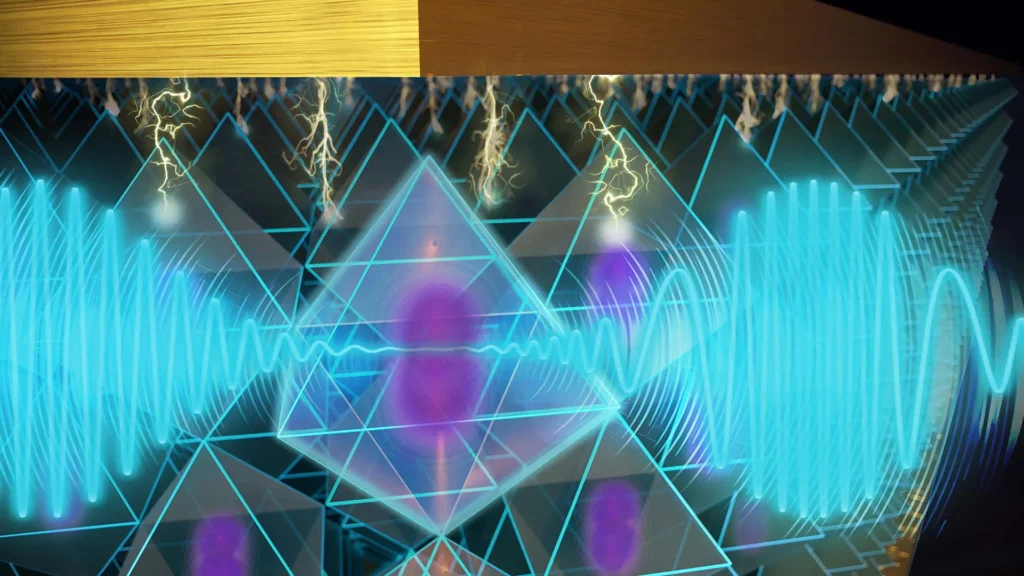Stanford’s Super Crystal That Could Transform Quantum Tech

Scientists at Stanford University have discovered a crystal that behaves in a surprising way.
Most materials become weak at very low temperatures, but strontium titanate (STO) becomes stronger.
It performs better when it is almost as cold as space.
This discovery could change the future of quantum computing, lasers, and space technology.
A Material That Refuses to Freeze — Literally
Most materials behave predictably in low temperatures:
they stiffen, weaken, or lose their optical and mechanical features.
But Stanford’s discovery shows that strontium titanate is different.
✅ It becomes more tunable.
✅ Its optical behavior strengthens instead of fading.
✅ Its mechanical stability improves at temperatures near absolute zero.
✅ And it outperforms every cryogenic material tested so far.
This is the scientific equivalent of finding a metal that becomes stronger underwater or a battery that lasts longer the colder it gets.
A Material That Refuses to Freeze — Literally
The world is racing toward quantum technology — a field that depends almost entirely on devices operating at ultra-low temperatures.
Quantum computers
Superconducting circuits
Laser systems
Cryogenic sensors
Space technologies
Quantum transducers
All of these require materials that don’t collapse or degrade in the cold.
Until now, researchers struggled because most known materials lose their properties when temperatures plunge.
But strontium titanate refuses to play by the old rules.
The 2025 Nobel Prize Set the Stage
The 2025 Nobel Prize in Physics honored groundbreaking work in superconducting quantum circuits.
It proved that quantum tech is no longer a theoretical dream — it is becoming real, fast.
However…
the biggest bottleneck remained the materials used inside these machines.
Quantum hardware only works properly at cryogenic temperatures.
At those temperatures, traditional materials behave unpredictably, making devices slow, unstable, or inefficient.
That’s where STO steps in.
A Crystal That Improves When the World Gets Colder
Stanford’s research, published in Science, reveals an extraordinary trait:
STO’s electro-optic effects become 40x stronger at cryogenic temperatures.
This is not a minor improvement.
It is a massive leap that could unlock entirely new engineering possibilities.
❄️ When STO is frozen:
Light becomes easier to control
Mechanical motion becomes more precise
Electric fields can manipulate light with incredible strength
Piezoelectric responses intensify
Nonlinear optical behaviors emerge
This is exactly what quantum engineers have been searching for.
Optical Performance: Light Bends Like Magic
STO is a nonlinear optical material, which means its optical properties shift dramatically when an electric field is applied.
At cryogenic temperatures, this effect becomes extreme.
Electric fields can now change:
✅ the frequency of light
✅ the phase
✅ the intensity
✅ the direction
✅ and even how light behaves inside quantum devices
This makes STO an ideal candidate for:
Quantum transducers
Microwave-to-optical converters
Cryogenic laser modulators
Light-based quantum switches
These technologies are essential for connecting quantum computers, satellites, and next-generation communication systems.
Piezoelectric Power: It Moves With Electricity
One of the most remarkable traits of strontium titanate is its piezoelectricity.
This means the crystal physically moves, expands, or contracts when an electric field is applied.
At extremely low temperatures, this property becomes even more powerful.
This makes STO perfect for:
Precision actuators
Cryogenic motors
Space-grade sensors
Rocket fuel system components
Low-temperature mechanical amplifiers
Imagine spacecraft hardware that performs better the further it travels from the Sun.
That’s the future STO makes possible.
Why This Material Was Overlooked for Decades
Strontium titanate is not new.
It has been around for years — inexpensive, accessible, and widely studied in basic physics.
So why did no one notice its true potential?
Simple:
No one tested it aggressively at cryogenic temperatures.
For decades, researchers assumed STO behaved like other common optical materials.
Only now — thanks to advanced measurement tools and quantum labs — has its extraordinary cryogenic behavior been revealed.
This transforms an ordinary crystal into an extraordinary one.
What Scientists Are Saying
Jelena Vučković, professor of electrical engineering at Stanford, explains:
“Strontium titanate has electro-optic effects 40 times stronger than the most-used electro-optic material today — and it works perfectly at cryogenic temperatures.”
Christopher Anderson, co-first author, adds:
“At low temperature, STO is the most electrically tunable optical material we know — and also the most piezoelectrically tunable.”
Those two features together make STO a once-in-a-generation discovery.
Where This Crystal Will Change the Future
✅ 1. Quantum Computing
The biggest challenge in quantum hardware is converting signals between systems.
STO could finally break this barrier.
Faster quantum switches
More efficient converters
More stable quantum circuits
✅ 2. Laser Systems
Cryogenic lasers used in research and satellite tech can become more powerful and more precise.
✅ 3. Space Exploration
In space, temperatures naturally drop to extremes.
A crystal that thrives in this environment is priceless.
✅ 4. Rocket Fuel Systems
STO-based cryogenic components could make rockets safer and more efficient.
✅ 5. Ultra-Sensitive Sensors
Low-temperature sensors used in astronomy and physics can reach new sensitivity levels.
A Cheap, Accessible, Game-Changing Material
Perhaps the most surprising part of this discovery is that STO is not rare.
It is not expensive.
It is not difficult to grow.
This is not a “lab luxury material”.
It is scalable, accessible, and industry-friendly.
This gives STO a very real chance of becoming a global standard in quantum materials — much like silicon became the backbone of modern computing.
Conclusion: A New Era of Cryogenic Materials Has Begun
Stanford’s discovery is more than a scientific achievement — it’s a turning point.
For the first time, engineers have a material that doesn’t just survive in extreme cold…
It excels in it.
Strontium titanate could become:
the backbone of quantum computers
the key to next-generation lasers
the foundation of space-grade sensors
the bridge that connects optical and electrical quantum systems
In other words:
this crystal could reshape the future of technology.
And the race to explore its full potential has only just begun.



